High Park—Swansea was a provincial riding in the west-end of the city of Toronto, Ontario, Canada. It was represented in the Legislative Assembly of Ontario from 1975 to 1999.
York South was a provincial riding in Ontario, Canada, that was represented in the Legislative Assembly of Ontario from 1926 to 1999.

Dovercourt was the name of a provincial riding in Ontario, Canada. It existed from the 1926 election to the 1999 election. When it was established, it bordered Brockton on to the west, York South to the north, and Bracondale on the east. Lake Ontario was its southern border for most of its existence. At its abolition in 1999, it consisted of that part of the city of Toronto bounded on the north by the former city limits, on the east by Bathurst Street, on the south by Bloor Street and on the west by the CN Railway and St. Clair Avenue. It was redistributed into Davenport, St. Paul's and Trinity—Spadina ridings.

Eglinton was a provincial electoral district located in Toronto, Ontario. From 1926 until 1999 it elected members to the Legislative Assembly of Ontario. At its abolishment in 1999 it consisted of the neighbourhoods of Davisville and Lawrence Park in the north end of the old city of Toronto. It was abolished into Eglinton—Lawrence, Don Valley West and St. Paul's.

Davenport is a provincial riding in Toronto, Ontario, Canada. It elects one member to the Legislative Assembly of Ontario.
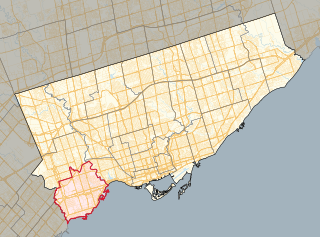
Etobicoke—Lakeshore is a provincial electoral district in Toronto, Ontario, Canada. It elects one member to the Legislative Assembly of Ontario.

York Centre is a provincial electoral district in Ontario, Canada, that has been the name of ridings in the Legislative Assembly of Ontario three different times. It was created initially in 1955 from the southern part of York North. It was dissolved in 1963 when it was split into three ridings called Yorkview, Downsview and Armourdale. In 1967, it was reconstituted north of Steeles in the township of Markham. This lasted until 1999 when it was dissolved into Markham—Unionville. The name was given to a new riding formed in its original location south of Steeles. It remains as an existing riding today.
Prescott and Russell was an electoral riding in Ontario, Canada. It existed from 1967 to 1999, when it was abolished into Glengarry—Prescott—Russell and Ottawa—Orléans when ridings were redistributed to match their federal counterparts. It consisted of the United Counties of Prescott and Russell as well as the Township of Cumberland.
St. George—St. David was a provincial electoral district in Ontario, Canada that existed between 1987 and 1999 that returned Members of Provincial Parliament (MPPs) to the Legislative Assembly of Ontario at Queen's Park.

St. Patrick was a provincial electoral district in Ontario, Canada, that was established in 1926 out of the district of Toronto Northeast. It lasted until 1967 when it was merged with St. Andrew to form St. Andrew—St. Patrick.

Humber River—Black Creek is a provincial electoral district in Ontario, Canada, that has been represented in the Legislative Assembly of Ontario since 1999. Prior to the 2018 election, the riding was known as York West.
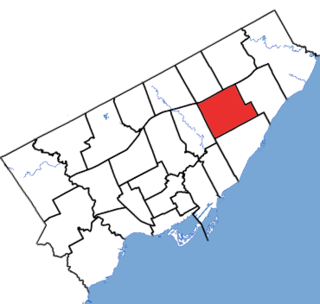
Scarborough Centre is a provincial electoral district in Ontario, Canada, that has been represented in Legislative Assembly of Ontario since 1963.
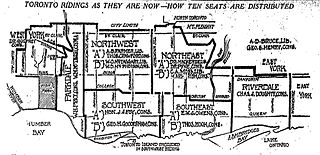
Toronto Southwest was an Ontario provincial electoral district in the old City of Toronto's west-end. It was represented in the Legislative Assembly of Ontario from 1914 until 1926, when it was abolished and redistributed into the Brockton, Dovercourt, Bracondale, Bellwoods, St. Andrew, and St. Patrick districts. It had two seats in the Legislature: Seat A and Seat B.

Toronto Southeast was an Ontario provincial electoral district that existed from 1914 to 1926. It occupied an area south of College and Gerrard between University and Logan Ave. In 1926 there was a major redistribution of Ontario seats which resulted in Toronto Southeast being split between three new ridings called St. George, St. David, and Riverdale.

Toronto East, also known as East Toronto, was a provincial riding that was created in Toronto, Ontario when the country of Canada was established in 1867. At the time Toronto was divided into two ridings, East Toronto and West Toronto. In 1886, these ridings were dissolved and a combined riding of the entire city was created which elected three members. In 1894 this riding was split into four parts of which Toronto East was one. It occupied the eastern part of the old city of Toronto. From 1908 to 1914 it elected two members to the legislature. In 1914 the riding was abolished and reformed into two new ridings called Toronto Southeast and Riverdale.

Toronto West, also known as West Toronto, was a provincial riding that was created in Toronto, Ontario when the country of Canada was established in 1867. At the time Toronto was divided into two ridings, West Toronto and East Toronto. In 1886, these ridings were dissolved and a combined riding of the entire city was created which elected three members. In 1894 this riding was split into four parts of which Toronto West was one. It occupied the western part of the old city of Toronto. From 1908 to 1914 it elected two members to the legislature. In 1914 the riding was abolished and reformed into three new ridings called Toronto Southwest, Toronto Northwest and Parkdale.
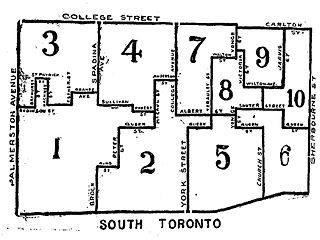
Toronto South, also known as South Toronto, was a provincial riding that was created in Toronto, Ontario in 1894. In 1886, Toronto was represented as one entire riding that elected three members. In 1894 this riding was split into four parts of which Toronto South was one. It occupied the southern part of the old city of Toronto. From 1908 to 1914 it elected two members to the legislature. In 1914 the riding was abolished and reformed into two new ridings called Toronto Southeast and Toronto Southwest.
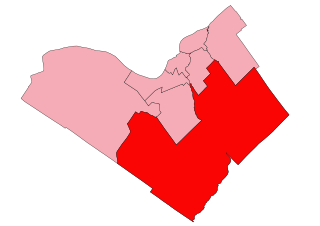
Carleton is a provincial riding in Ontario, Canada. It was created in 1867 at the time of confederation and lasted until provincial redistribution in 1996. In the 1999 provincial election it was redistributed into Nepean—Carleton and Lanark—Carleton. In 2007 it was abolished into Carleton—Mississippi Mills and Lanark—Frontenac—Lennox and Addington.

Mississauga—Lakeshore is a provincial electoral district in Ontario, Canada. It elects one member to the Legislative Assembly of Ontario. This riding was formerly known as Mississauga South prior to 2015.
Prince Edward was an electoral riding in Ontario, Canada. It was created in 1867 at the time of confederation and was abolished in 1933 before the 1934 election.











